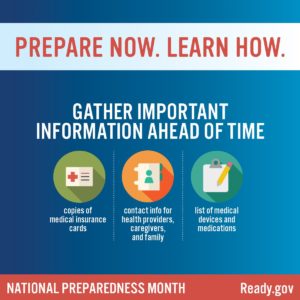car safety
If you need to evacuate, there are some extra tools that can help drivers with disabilities stay safe behind the wheel.
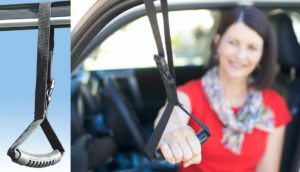
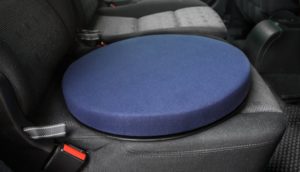
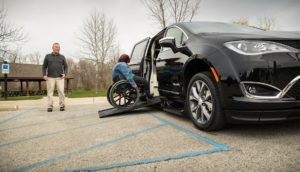
- Siren alert device: Compatible with both your home and vehicle, a siren alert is an easy way to call for help in an emergency, especially for those drivers with hearing loss.
- Driving glasses: Driving requires you to see in detail, something that isn’t easy for everyone. A pair of glasses can ensure clear vision and also serve as an anti-reflective tool when driving at night.
- Assist bars or straps: A sturdy assist bar or strap can help you pull yourself in and out of the vehicle.
- Swivel cushion: A swivel cushion can help you move from a wheelchair to the driver’s seat with far less trouble by turning with you to ensure easier movement.
- Turny or valet seat: A turny, or valet seat, is another way to transfer from a wheelchair to your car by using a seat that exits the vehicle and lowers itself down to the appropriate height of your wheelchair.
- Car ramps: A car ramp allows you to simply wheel your chair into the vehicle without any need to leave your wheelchair at all.
- Reclining seats: Reclining seats ensure comfort and make it easier for you to move in and out of the car.
- Hands-free navigation: Eliminate one worry by utilizing hands-free navigation that can keep you on track with minimal disruption.
- Lane-keeping assist: Lane-keeping assist is a newer technology that will sound an alert if you stray from your lane.
- Pedestrian detection: Pedestrians can dart into traffic without warning, but pedestrian detection can slow or stop your vehicle immediately in response.
- Forward collision warning: If a car suddenly stops or cuts in front of you, a forward collision warning helps prevent a collision by hitting the brakes.
home safety
As important as it is to secure yourself outside of the home, you also must secure yourself within your house, and these tips can help.
- Register for emergency assistance: The federal Disaster Assistance program can help you find an emergency management agency in your state, as well as medical and other disaster relief in your area.
- Have a plan: Work with the other members of your household to create a plan of action if there is an emergency. Your plan should include everything from evacuation routes and local shelters to communication and preparation for your pets and service animals.
- Know your support network: Identify what resources are available to help in a crisis, and connect with neighbors, caregivers and out-of-town family members to collaborate on emergency preparedness and evacuation.
- Have seats in the showers: A seat in the shower can help prevent slips and falls, especially if you are in a hurry. Invest in a mobile version that can be taken with you if you need to leave home.
- Grab bars and safety rails: Like a shower seat, grab bars and safety railings can help provide stability and balance when moving around the house.
- Wider hallways: Investing in wider hallways can simplify and improve mobility by providing room for wheelchairs and making it easier to move with bags and belongings.
- Pillow and bed alarms: These special alarms are designed to wake even the deepest sleeper with optional sound, vibrating and shaking effects.
- Light alarms: These alarms can also ensure that you wake by using bright lights to signal that it is time to wake up.
- Alexa and Google Home: These smart home systems use technology to simplify your life, doing everything from turning off the lights to locking doors with just the touch of a button.
- Set appliance reminders: Many appliances have easy reminders that you can set and use to turn your appliances on and off even if you are away from home.
- Reduce the risk of falls: Keeping your home tidy and free of clutter can help reduce the risk of trips and falls.
*These tips are courtesy of BankRate Insurance, we do not endorse this company*
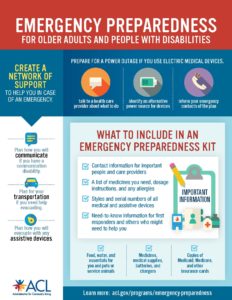
Build a Kit
In addition to having your basic survival supplies, an emergency kit should have items to meet your individual needs in various emergencies. Consider the items you use on a daily basis and which ones you may need to add to your kit.
Tips for People Who are Deaf or Hard of Hearing
- A weather radio (with text display and a flashing alert)
- Extra hearing-aid batteries
- Pen and paper (in case you have to communicate with someone who does not know sign language)
Tips for People Who are Blind or Have Low Vision
- Mark emergency supplies with Braille labels or large print. Keep a list of your emergency supplies and where you bought them on a portable flash drive or make an audio file that is kept in a safe place where you can access it.
- Keep communication devices for your particular needs, such as a Braille or deaf-blind communications device as part of your emergency supply kit.
Tips for People with Speech Disability
- If you use an augmentative communications device or other assistive technologies plan how you will evacuate with the devices or how you will replace equipment if it is lost or destroyed. Keep model information and note where the equipment came from (Medicaid, Medicare, private insurance, etc.).
- Plan how you will communicate with others if your equipment is not working, including laminated cards with phrases and/or pictogram.
Tips for People with a Mobility Disability
- If you use a power wheelchair have a lightweight manual chair available as a backup if possible. Know the size and weight of your wheelchair in addition to whether or not it is collapsible, in case it has to be transported.
- Show others how to operate your wheelchair.
- Purchase an extra battery for a power wheelchair or other battery-operated medical or assistive technology devices. If you can’t purchase an extra battery, find out what agencies, organizations or local charitable groups can help you buy one. Keep extra batteries on a trickle charger at all times.
- Consider keeping a patch kit or can of sealant for flat tires and/or extra inner tube if wheelchair or scooter is not puncture proof.
- Keep an extra mobility device such as a cane or walker if you use one.
- Keep a portable air pump for wheelchair tires.
- If you use a seat cushion to protect your skin or maintain your balance and you must evacuate, have an extra cushion to take with you.
Tips for Individuals with Sensory Disabilities (including autism spectrum disorder)
For people with sensory disabilities, this may include:
- Handheld electronic devices (loaded with movies and games)
- Spare chargers
- Sheets and twine or a small pop up tent (to decrease visual stimulation in a busy room or to provide instant privacy)
- Headphones (to decrease auditory distractions)
- Comfort snacks
Additional Items
- At least a week-long supply of prescription medicines
- A list of all medications, dosage and any allergies
- Extra eyeglasses
- Extra hearing aid batteries
- Extra wheelchair batteries (or a manual wheelchair if possible)
- Oxygen
- A list of the style and serial number of medical devices (include special instructions for operating your equipment if needed)
- Copies of medical insurance and Medicare cards
- Contact information for doctors, relatives or friends who should be notified if you are hurt
- Pet food, extra water, collar with ID tag, medical records and other supplies for your service animal

